Drinking from the firehose of Covid-inspired innovation
Will the great ideas kickstarted by the pandemic be more than a blip?


 Much of the history of the world has been created out of necessity, with turbulence forcing innovation, invention, and adjustment. Covid-19 appears to be following this path
Much of the history of the world has been created out of necessity, with turbulence forcing innovation, invention, and adjustment. Covid-19 appears to be following this path
Image: Shutterstock
Covid-19, says Steve Davis, has provided “a petri dish for the real-time study of social innovation."
As the co-chair of the World Health Organization’s Digital Health Technical Advisory Group, he’s witnessed a surge of digital tools for testing and tracing, an experience he likens to “drinking from a firehose of innovation." Metaphors aside, the challenge, Davis says, is to build a better system for making sure great ideas really work, scale, and reach the people who need them.
There are a lot of challenges for sure, and I don’t mean to be Pollyannaish or naïve. But three things give me a lot of hope. One is the way the innovation community has shown up over the past 18 months. That gives me hope because I think so much of the history of the world has been created out of necessity, with turbulence forcing innovation, invention, and adjustment. Covid-19 appears to be following this path.
The second is collaboration. Multisector partnerships are so critical. We’ve got to bring the private, public, and social sectors together more frequently and more effectively in order to battle climate change, address inequity, and create better health conditions. We saw a lot of that happen in the last year and a half. Now the question will be what sticks, and how we leverage those opportunities.
And then the final thing — it sounds so trite as a professor to say this — is the talent and optimism in many of the young people that I work with. There are so many next-generation leaders that look a lot different than leaders in my generation: much more diverse, much more global, much more reflective of the world we live in. I feel like there’s a lot of opportunity and I don’t think we’re going to go backward.
Yeah, I do. It’s been an extraordinary experience to be on the receiving end of so many incredibly great ideas. A bunch of interesting tools around testing and treatment were quite successful and will be built into the health systems of the future. People were forced to do telehealth for a year and now they’re saying, “Why do I need to go into my doctor’s office?" The world of online education — we just accelerated its uptake by a decade. We had all these new data visualization, aggregation, and analysis capabilities — everybody in the world pretty much knew what it meant to flatten the curve. I think that these innovations are changing our collective mindsets about what’s possible in our lives beyond the pandemic.
 A pandemic can be a horrible time to be piloting and testing brand new ideas. In such a crisis, you’ve got to go in and get the thing that works quickly, even if it’s not perfect. The perfect was frequently the enemy of the good in a lot of these areas. A real problem was that there was all this innovation and there were all these communities in need, but there wasn’t a very good mechanism to match them. We’ve got some hard work to do now to respond to that, to build a better global health architecture, financing, and policy framework ahead of the next pandemic.
A pandemic can be a horrible time to be piloting and testing brand new ideas. In such a crisis, you’ve got to go in and get the thing that works quickly, even if it’s not perfect. The perfect was frequently the enemy of the good in a lot of these areas. A real problem was that there was all this innovation and there were all these communities in need, but there wasn’t a very good mechanism to match them. We’ve got some hard work to do now to respond to that, to build a better global health architecture, financing, and policy framework ahead of the next pandemic.
One of the complicated conversations we are having is how do we manage this really dynamic world of digital health — remote technologies, AI, self-reporting tools, and telemedicine. We don’t have a regulatory mechanism to decide which tools are good and which aren’t. And I don’t think we really want digital tools to be overly regulated because they’re so dynamic. Maybe it’s better to create a more distributed mechanism with the corporate and innovation community driving it. But we have to be careful that the inmates aren’t in control of the asylum.
The lack of good regulation has actually hindered innovation in this instance, because so many people had great ideas, but there wasn’t the proper policy framework for equitable access, so they often didn’t get deployed. They didn’t know who to go to, and they didn’t know if it was going to be approved. That’s why sometimes the typical Silicon Valley view is that regulation is a hindrance to innovation. But in this case, I would argue the opposite: The lack of regulation and proper public sector engagement actually hindered innovation.
First Published: Jan 21, 2022, 11:04
Subscribe Now